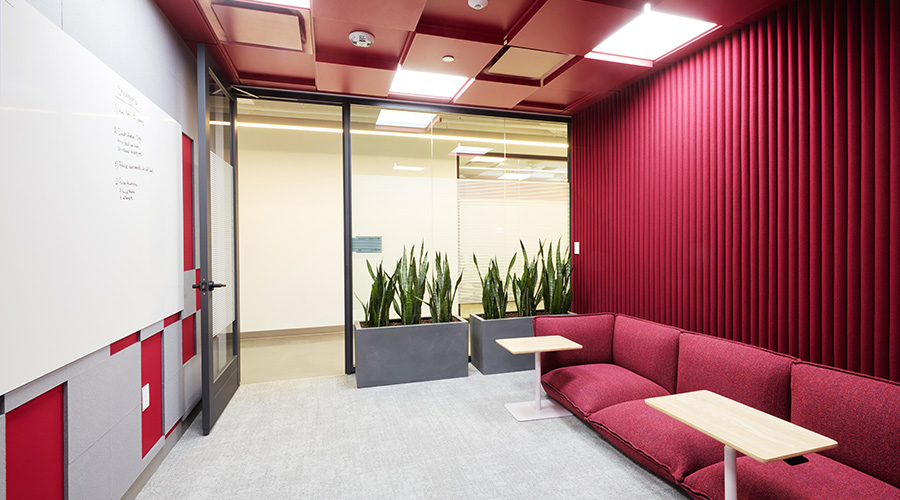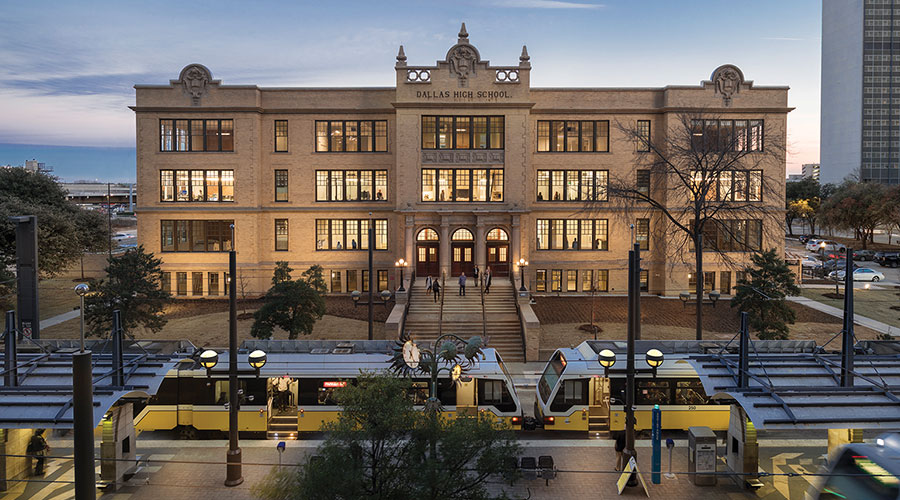UN-common Challenge
Overburdened facilities. An outdated infrastructure. Years before help arrives. Here’s how one department keeps the United Nations’ aging complex operational
Behind its beautiful architecture and grand allure, the United Nations (UN) headquarters houses an unsettling surprise. The half-century-old equipment that keeps the international landmark operating is in dire condition, literally rusting away in places. With a growing number of occupants and high-tech systems, electrical systems operate dangerously close to their maximum loads. More alarmingly, the Secretariat and General Assembly buildings have numerous safety hazards, including asbestos, lead paint and inadequate fire protection.
“Only four levels in the Secretariat building have fire-sprinkler systems,” says Giulio Mantin, the UN’s chief of plant engineering. The Secretariat has 40 floors and three basement levels.
UN officials are preparing a capital master plan (CMP), a more than $1 billion renovation that will make the complex energy efficient, free of hazardous materials and compliant with building, fire and safety codes. The renovation, however, won’t begin until at least 2007.
In the meantime, the challenge for the UN’s maintenance department is to keep the current equipment operative and meet the demanding expectations that come with running a high-profile, international government facility in the heart of New York City. The UN headquarters, which is considered international territory, is waiting for the U.S. Congress to approve a loan that will finance the CMP.
“Right now, the capital master plan is not affecting the maintenance department’s operations,” says Mantin, adding that he expects his department to continue maintaining most of the vintage machinery for another four years.
“While we wait for the capital master plan, we must assure that all machines continue to run because if something fails, it’s still my responsibility to get it fixed,” he says.
Aging Infrastructure
UN’s General Assembly and Secretariat buildings were constructed between 1949 and 1952, and their mechanical systems consist mostly of original parts. Since the buildings’ construction, the maintenance department has been unable to upgrade much of the equipment because of budget restrictions.
“By today’s engineering standards, a unit that lasts 15 years has completed its life cycle,” says Claudio Santangelo, the UN’s building management officer. “Under these standards, our equipment has been operational three to four times beyond its life cycle.”
While preventive maintenance (PM) plays a big part in keeping the systems operating, the department is unable to perform all of the recommended PM because of staffing shortages, Santangelo says.
While technology and occupancy have grown over the years, the maintenance department’s staff has shrunk. During the past 10 years, the in-house trades and craft staff has decreased from 160-170 people to about 65 people.
“The reduction in manpower has placed a tremendous stress on everyone in the maintenance department,” Santangelo says, adding that credit for the equipment’s longevity should go to the individuals who served in the UN’s maintenance department for the first 30 years.
“The majority of the work we do is corrective maintenance as a result of emergencies,” Santangelo says. “I would say 80-90 percent of the corrective maintenance is due to the equipment being old. A majority of the HVAC systems can no longer provide efficiency, so they frequently breakdown,” he says. Common problems include motor breakdowns, along with broken belts, bearings and air-control components.
The facility’s screen system, which filters water from the East River that is used to cool refrigerant in the chillers, currently is causing the most malfunctions to the chiller plant. The chillers have relied on the system’s sets of rotating metal filters for about 54 years.
“The system has experienced a lot of breakdowns lately due to old age, fatigue and corrosion from the salt water,” Santangelo says. “It’s so old that the metal has corroded and is literally breaking apart, making it difficult for the system to rotate. With-out rotation, debris is going to keep collecting on the same surface area.” A second screen serves as a backup, but it also is in bad shape.
“I’m holding on for dear life to get them temporarily repaired and then completely overhauled,” Santangelo says. To replace the units requires that equipment installers shut down the entire central air-conditioning system, which would affect the entire UN complex.
“At that point, we might as well shut down the entire building,” Santangelo says. “We are doing everything we can not to reach that point.”
To avoid lengthy downtime, the maintenance department stocks some parts, but many components must be manufactured in-house. Obtaining replacement parts can be a challenge because some original equipment manufacturers are out of business.
Nonetheless, the department has a major responsibility to meet occupant expectations for building operations, as HVAC system failures can lead to severe political consequences.
“If a head of state is sweating profusely, the maintenance department is really put on the spot,” Mantin says. “Imagine the Security Council holds a meeting regarding a conflict that involves a particular country, and the air-conditioning system fails to operate. First, the member states will complain to the Secretary General. Second, the country that is the focus of the deliberation may arrive at the wrong conclusion,” he says, adding that some individuals might suspect the shutdown was intentional.
“We would have to explain and assure the member states that old machines have no alliance, they just breakdown,” he says.
Overloaded Facilities
In addition to keeping antiquated equipment functional, the maintenance department also must cope with an increase in facility use. More people work in and visit the buildings and use more electricity than the complex was designed to accommodate.
“Since its construction, the number of meetings that occur here has increased tremendously,” Santangelo says. The additional occupants, coupled with the introduction of computers, has significantly increased the power and cooling requirements. As a result, the department must constantly modify the facility’s infrastructure to provide more heat, air conditioning and electricity.
“The building has really been tapped on the load that is being placed on the power and cooling systems,” Santangelo adds.
“A building that almost didn’t have any wires in it when it was constructed now has a tunnel of wires in it,” Mantin says. “We have to continually keep adding more and more wires, or demand for automation and efficiency increases.
“Within the complex’s 3.5 million square feet, which stretches from 42nd to 48th streets and from the East River to 1st Avenue, I estimate there to be hundreds of thousands of miles of wires.”
“It is just overwhelming,” Mantin says. “We’re doing what we can with our computerized system to maintain whatever information possible.”
Game-plan Anticipation
While dealing with the problems associated with the rusting equipment and rising expectations for facility performance, the maintenance department also is looking toward the future and assisting with the CMP.
“The CMP will look at all issues we’re dealing with today and bring the buildings up to date with the latest technology,” Mantin says. “It will enable us to control all of the energy uses, as well as eliminate the asbestos problem and introduce the sprinkler system and other safety features.”
As part of the CMP, the UN contracted with design and architectural firms to investigate building conditions. Almost every week for two and a half years, the department has given designers and architects tours of the complex and provided them with information on its infrastructure and equipment, including HVAC, electrical, gas, and plumbing systems.
“The property is immense,” Mantin says. “We have been helping them become familiar with all the levels of the buildings, from the basements to the roofs. The information is extremely intricate. They want everything from direction of steam lines, to electrical services, how wires split, which floors control what, how the air conditioning plant works, and all other information on how these buildings function.”
The outside firms will use this information to determine their renovation strategy and help specify new equipment.
“The CMP is an undertaking that involves much more than just the technical part,” Mantin says. In order to replace the centralized air conditioning, install the sprinkler system and remove the asbestos, the headquarters must be vacated and moved to a swing space.
The UN has requested that New York City approve construction of a 35-story building one block south of the UN headquarters. The plan is to relocate the 3,600 headquarter occupants temporarily to the “swing space” building. Under the current schedule, that building would be ready for occupancy in 2007.
The plan includes gutting the Secretariat and areas in the General Assembly building, leaving only their shells. The infrastructure, including electrical distribution, air conditioning and plumbing systems and computer and telephone networks, must be completely updated.
“Everything is still in the planning stage,” Mantin says. “We don’t even know what the equipment is going to be yet.” Right now, the department’s main focus is to keep the organization running smoothly until the renovation begins.
“The UN is an international body that has to be operational 24 hours a day, 365 days a year,” Mantin says. “Our job in keeping the buildings operational is a huge responsibility. This is where the member states and the Secretary General communicate with the rest of the world. Right now, my main concern is to keep the current equipment running and assure that the buildings are fully operational.”
Taking Charge in a Crisis
In the aftermath of the terrorist attacks of 9/11 and during the blackout in August 2003 the United Nations (UN) headquarters stayed operational. During these emergencies, individuals in the UN’s maintenance and security departments stayed at the complex for days. As a result of these emergencies, the UN’s maintenance department recently established its Engineering Crisis Center to better prepare itself for future crisis situations.
“The center is a place where we can address the crisis at-hand engineering-wise,” says Claudio Santangelo, the UN’s building management officer. The center is located near his office and those of shop foremen.
“In the event of an emergency, the UN’s command center will give instructions to the engineering crisis center,” says Giulio Mantin, the UN’s plant engineering chief.
“By congregating in one area, it’s much easier for the plant engineering and facilities management units to coordinate their efforts,” Santangelo says.
In addition to serving as a staging area for operational purposes, the center is designed as a place where staff can rest and find water and basic necessities.
“During the blackout last year, we found ourselves here for four days with very little food,” Mantin says. No food was available outside the complex because food in most stores spoiled after 24 hours.
The department now keeps nonperishable food in the center, as well as several supplies that could be useful in emergencies, including flashlights and portable generators. The staff also is analyzing other possible emergencies and taking appropriate precautions.
“We’re in the last stages of putting the center under generator power so that even if New York is out of power, we’re not,” Santangelo says.
Adds Mantin, “Because we can never be sure of what is going to happen, we are trying to prepare ourselves, as best as possible, for any crisis that may occur.”
|
SNAPSHOT: United Nations
Area: 3.5 million square feet. The complex includes:
-
the Secretariat, a 40-floor office tower
-
the General Assembly building, where all member nations of the United Nations meet in the UN General Assembly
-
the Dag Hammarskjold Library.
Maintenance Department: 65 people in trades and 15 in administration and management.
Facility Uses: Offices, conference rooms, cafeterias, mechanical shops, printing plant, video and audio studios, post office, garages, and fire and safety departments.
|
Related Topics:











